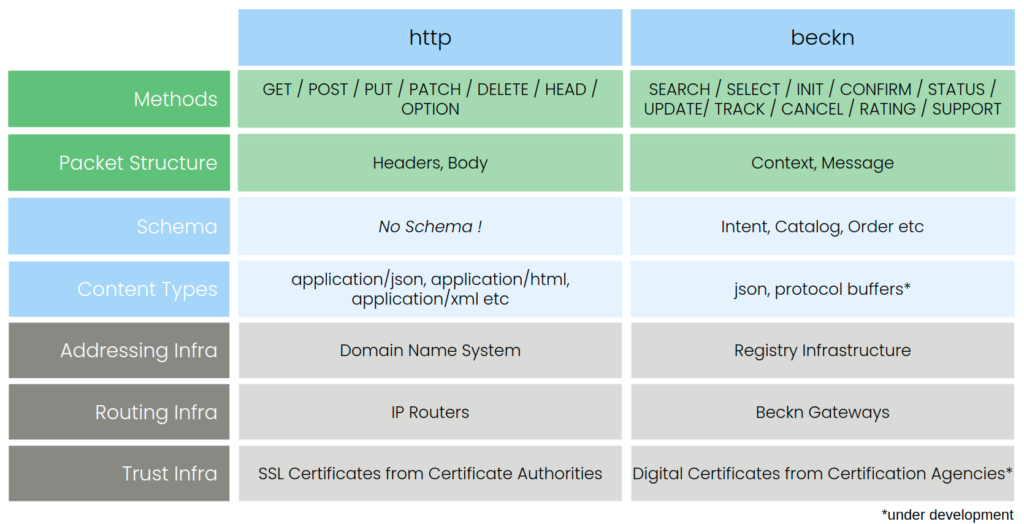Introduction
Topic Summary (TL;DR)
Beckn (short for beckn protocol) is an open protocol for decentralized commerce. It consists of several specifications for building open e-commerce networks across which sellers and their offers are universally discoverable from any Beckn-enabled app or platform. As a protocol, Beckn is multi-layered, with layer structure and organization resembling that of HTTP.
The architecture of the Beckn ecosystem has five layers (from top to bottom):
- Application layer
- Network and Transaction layer
- Infrastructure and Security layer
- Certification layer
- Specification and Support layer
All components of the Beckn ecosystem are, as of July 2021, live and operational on production platforms except for the Certification component which has one of its specifications still under development. There are four Beckn domain-based communities that work to implement Beckn in their respective industries and, as a result of their work, four Beckn-enabled networks.
What is Beckn?
Beckn is an open protocol for location-aware, local commerce. It makes it possible services and sales offers to be discovered across industries and fetched by any consumer application. Thus it helps deliver offers and services to the shopper seamlessly, by combining offer/services of any form or provider. The protocol takes advantage of the 5G and high-speed network technologies to implement e-commerce capability in the network and/or the transport layer. This makes the sales offers or services open and accessible to the Application layer of any Beckn-aware implementation. The Beckn protocol is implementable also on middleware and firmware levels.
The Beckn Protocol is a collection of open specifications that deliver Beckn’s functionality. The specifications consist of protocol APIs, message formats, network design and reference algorithms, which allow multiple commercial service provider entities to bring their services together to offer one seamless integrated experience to their customers.
The Beckn Protocol de-couples the demand-side digital infrastructure (apps and other channels) from the supply-side service provisioning infrastructure. It does this by making integrated location-aware services available not just on a single platform but potentially on any online consumer interface (online maps, messaging, wallets, voice assistant apps and devices) that has mainstream adoption in a city.
Beckn is a protocol, not a platform. It has a decentralized architecture that obviates the need for creating a centralized platform in order to integrate services from multiple providers simultaneously. The protocol ensures privacy and security by design by enabling secure, privacy-protected interactions.
The Interoperability protocol allows two entities in an integrated ecosystem to communicate with each other through structured flows and role definitions. The Server-To-Server Communication protocol allows any consumer-facing online platform to discover and transact with location-aware remote services with minimal implementation overhead. A single message packet generated at run-time, hence, could contain services from multiple providers.
Multi-Layered Structure of the Protocol
The Beckn protocol consists of several specifications because the creation of an open network requires the implementation of multiple layers of infrastructure, and each layer has its own specification. The HTTP protocol, for example, would not be able to deliver its functionality without its multiple layers, and the same applies to Beckn. The table below shows a comparison between the HTTP and Beckn protocols across various factors like methods, scaffolding, infrastructure, etc.. As you can see, Beckn draws a lot of its inspiration from HTTP.

Beckn Ecosystem Architecture
Beckn architecture prescribes multiple layers stacked on top of one another, each with clearly defined roles and functions, as evident from this diagram:

Every entity that wants to be part of the network must be in one or more of the layers listed in the left column.
The bottom two layers — the Specification and Support layer and the Certification layer — provide all the resources and support required to implement the network, to test for compliance and to become certified to join the network.
The top two layers are the actual run-time of the specification in the form of the Application layer which constitutes the consumer and the provider interfaces, and the Network and Transaction layer which has the server-side applications and the routing infrastructure.
In the very middle is the Infrastructure and Security layer. This layer holds the underlying infrastructure that transforms the Beckn-compliant platforms into actual live transacting entities on an open network. The layer comprises of open registries which list the various platforms and makes them this discoverable by other platforms — a role similar to that of the domain name system (DNS) in HTTP.
Each of these layers has undergone unique independent evolution in terms of complexity and scale. Together, they all work in concert to create the ecosystem of Beckn.
Developer Ecosystem Components
This diagram shows the various components of the Beckn ecosystem, its “building blocks”:

Of these, the only component which is not on a production platform yet (as of July 2021) is the Certification specification: it has its core specifications, domain specific taxonomies, security and trust models designed already; the open certification specification is still under development.
The developer ecosystem is built around some sandboxes, API wrappers (for platforms that have their own APIs), multiple communities for the various domains like delivery, mobility, local retail, etc., and certification agencies which implement the open certification spec.









